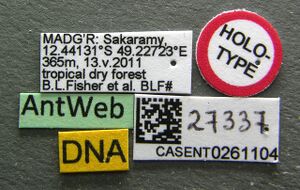Leptogenys diana
| Leptogenys diana | |
|---|---|

| |
| Scientific classification | |
| Kingdom: | Animalia |
| Phylum: | Arthropoda |
| Class: | Insecta |
| Order: | Hymenoptera |
| Family: | Formicidae |
| Subfamily: | Ponerinae |
| Tribe: | Ponerini |
| Genus: | Leptogenys |
| Species group: | truncatirostris |
| Species complex: | truncatirostris |
| Species: | L. diana |
| Binomial name | |
| Leptogenys diana Rakotonirina & Fisher, 2014 | |
Leptogenys diana has been found foraging on the ground and nesting under rocks and in rotten logs. Though its hunting habits are not known, the shape of the mandible with the strange, soft striate outer surface, and the limited anterior clypeal lamella, no doubt have interesting behavioral implications.
Identification
A member of the truncatirostris complex of the truncatirostris species group. Rakotonirina and Fisher (2014) - Worker. Clypeus broadly rounded, without projecting anteromedian lobe; median clypeal carina lacking; lateral portion joins anterior margin of clypeus in a convex line. In profile, mandible strongly bent downward;in full-face view, blades clearly broadened and flattened at about mid-length, with longitudinal and fine striation; inner margin evenly curved from distal half to apical sharp tooth; in profile, third abdominal segment microreticulate (coriaceous) with scattered punctures; dorsum of mesosoma, petiolar node, and gaster without pubescence.
This species can be confused with Leptogenys truncatirostris, but the latter is characterized by a broad anterior margin of the clypeus with angulate lateral margins; the abundant pubescence on the dorsum of the mesosoma, petiolar node and gaster; and dense reticulate punctures on the third abdominal segment.
Keys including this Species
Distribution
Leptogenys diana is restricted to the dry forest of the Montagne des Français and RS Ambre near the northern tip of the island, in two disjunct populations.
Latitudinal Distribution Pattern
Latitudinal Range: -12.4423° to -12.4423°.
| North Temperate |
North Subtropical |
Tropical | South Subtropical |
South Temperate |
- Source: AntMaps
Distribution based on Regional Taxon Lists
Malagasy Region: Madagascar (type locality).
Distribution based on AntMaps
Distribution based on AntWeb specimens
Check data from AntWeb
Countries Occupied
| Number of countries occupied by this species based on AntWiki Regional Taxon Lists. In general, fewer countries occupied indicates a narrower range, while more countries indicates a more widespread species. |

|
Estimated Abundance
| Relative abundance based on number of AntMaps records per species (this species within the purple bar). Fewer records (to the left) indicates a less abundant/encountered species while more records (to the right) indicates more abundant/encountered species. |

|
Biology
|
Castes
Worker
Images from AntWeb
   
| |
| Holotype of Leptogenys diana. Worker. Specimen code casent0261104. Photographer Estella Ortega, uploaded by California Academy of Sciences. | Owned by CAS, San Francisco, CA, USA. |
Nomenclature
The following information is derived from Barry Bolton's Online Catalogue of the Ants of the World.
- diana. Leptogenys diana Rakotonirina & Fisher, 2014: 145, figs. 12A, 162, 171 (w.) MADAGASCAR.
Unless otherwise noted the text for the remainder of this section is reported from the publication that includes the original description.
Description
Worker
(5 specimens). HW: 1.66–1.77, HL: 1.81–1.89, CI: 91–43, SL: 1.79–1.85, SI: 105–109, PW: 1.13–1.20, WL: 2.89–3.15, PNH: 0.96–1.05, PNL: 0.87–0.95, PNW: 0.87–0.91, DNI: 95–100, LNI: 108–117.
Head subquadrate, not diverging anteriorly; sides nearly straight; posterior margin slightly concave. Eye large, occupying one-third to one-fourth the length of lateral cephalic margin and extending beyond line of sides of head. Antennal scape relatively short, roughly one-fifth of its length surpassing posterior cephalic margin. In profile, mandible strongly bent downward; in full-face view blade increasing in width at distal half, then gradually, narrowly arched toward apex; small preapical tooth may be present. Anterior clypeal margin meets lateral portions in rounded angle, anterior lamella limited to anteromedian portion, not broadly covering the clypeus; medial longitudinal carina absent. Antennal scape relatively short, roughly one-fifth of apical portion surpassing posterior cephalic margin. With mesosoma in dorsal view, metanotal groove cross-ribbed; in lateral view, posterolateral border of propodeum smooth, without toothlike lobe. Outer surface of mandible from distal half to apex densely and finely striate, softcuticleand golden in color. Dorsum of head, mesosoma and petiolar node densely reticulate-punctulate. Third abdominal tergite generally microreticulate or coriaceous, with scattered punctures. Dorsum of mesosoma, petiolar node, and gaster covered with erect hairs; pubescence absent. Color black, with brown to light brown apical portion of appendages and tip of gaster.
Type Material
Holotype worker: Madagascar, Antsiranana, RS Ambre, Sakaramy, -12.4423, 49.2288, 402 m, tropical dry forest, ex rotten log, 15 May 2011 (B.L. Fisher et al.) collection code: BLF27337, CASENT0261104 (California Academy of Sciences). Paratype worker: with same data as holotype but specimen coded: CASENT0261074 (CASC).
References
- Rakotonirina, J.C. & Fisher, B.L. 2014. Revision of the Malagasy ponerine ants of the genus Leptogenys Roger (Hymenoptera: Formicidae). Zootaxa 3836, 1-163.
References based on Global Ant Biodiversity Informatics
- Rakotonirina J. C., and B. L. Fisher. 2014. Revision of the Malagasy ponerine ants of the genus Leptogenys Roger (Hymenoptera: Formicidae). Zootaxa 3836 (1): 001163.

